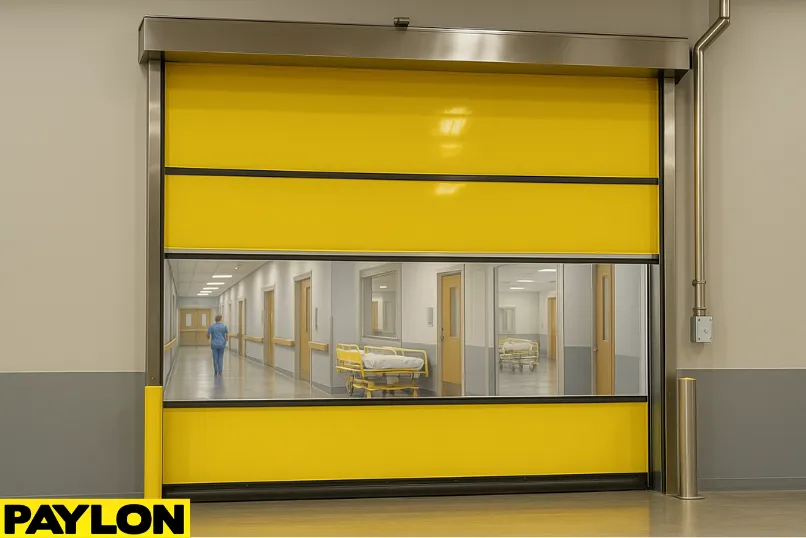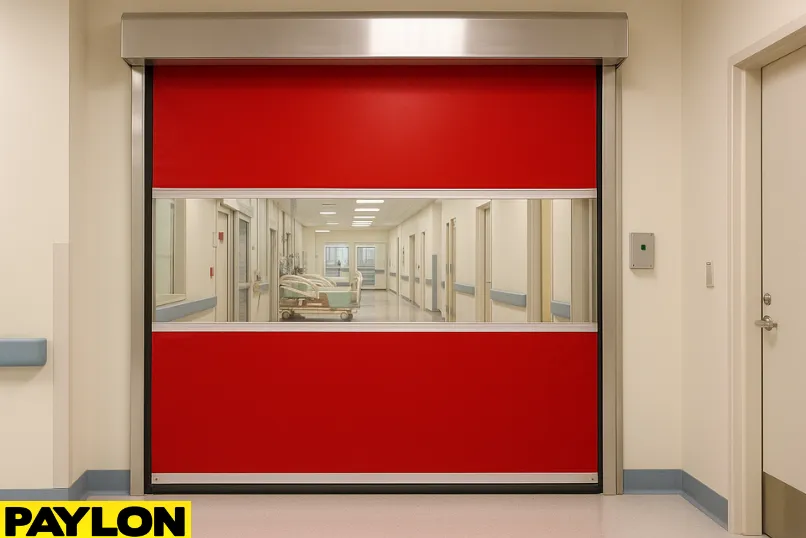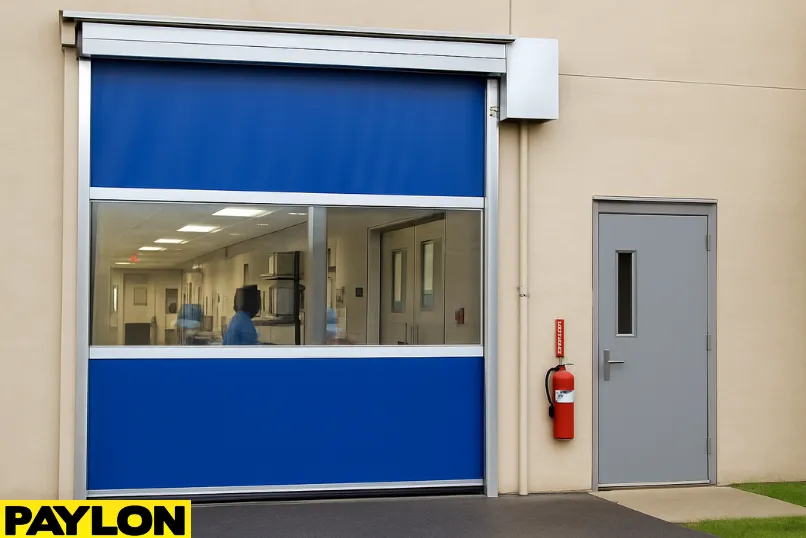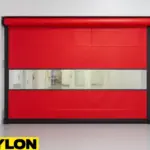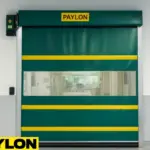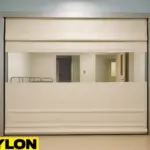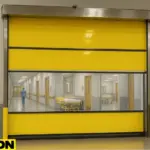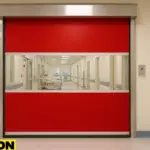Smarter Quarantine Zone Separation
In healthcare, speed and safety matter. Discover how vinyl roll-up barriers offer clean, flexible protection for medical zone, without permanent construction.
Vinyl roll-up barriers are more than just compact, they’re essential to safer facility layouts. From sterile corridors to temporary triage zones, they help healthcare teams control movement and reduce risk. The infographic below shows where these doors work best. Still unsure which type fits your needs? Paylon’s team is ready to help.
Vinyl Door Solutions for Safer Quarantine Zone Separation
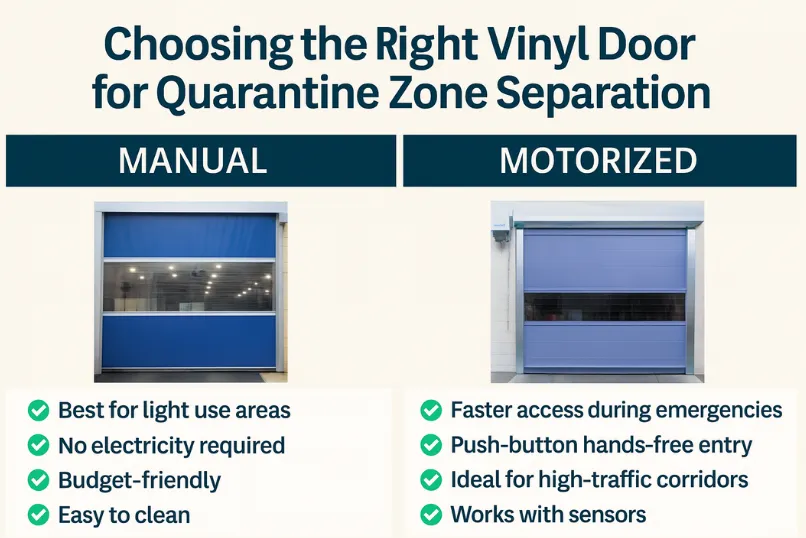
Vinyl roll-up barriers aren’t just space-saving, they’re lifesaving. Whether you're converting a hallway into a sterile corridor or setting up a temporary triage zone, these doors create instant separation with visibility and hygiene in mind. Use this infographic to better understand where and how vinyl roll-up barriers fit into your infection control strategy. If you're unsure which model fits your space, our experts at Paylon are here to help you every step of the way.
What Are Vinyl Roll-Up Barriers and How Do They Work?
It comes down to smart engineering. These doors use vertical rolling mechanisms to open and close quickly, making them ideal for spaces where speed and sanitation matter. Let's take a closer look at how they work and what sets them apart.

Flexible Operation Types:
Choose from manual (spring-loaded or chain-hoist), motorized (plug-in controls), or high-speed doors for rapid cycling in fast-moving zones.
Durable Vinyl Construction:
Made from 22 to 40 oz industrial-grade vinyl, these barriers withstand repeated use, cleaning agents, and temperature shifts.
Clear PVC Windows for Visibility:
Optional see-through panels offer safe monitoring without crossing into restricted areas.
Safety-First Design:
Break-away bottom bars reset on impact to prevent damage and reduce downtime in case of collisions.
Low-Maintenance & Easy to Clean:
Fewer moving parts mean fewer issues. Wipe-down surfaces make disinfecting quick and efficient.
Adaptable to Your Layout:
Can be custom-fit to almost any opening—perfect for tight corridors, storage rooms, or cleanroom access points.
Whether you’re outfitting a high-traffic zone or a quiet access point, vinyl roll-up doors are built to meet the demands of modern medical spaces.
Key Benefits in Medical & Quarantine Environments
Vinyl roll-up barriers don’t just fit, they perform. Designed with infection control in mind, these barriers create cleaner zones, smarter traffic flow, and less strain on your HVAC systems.
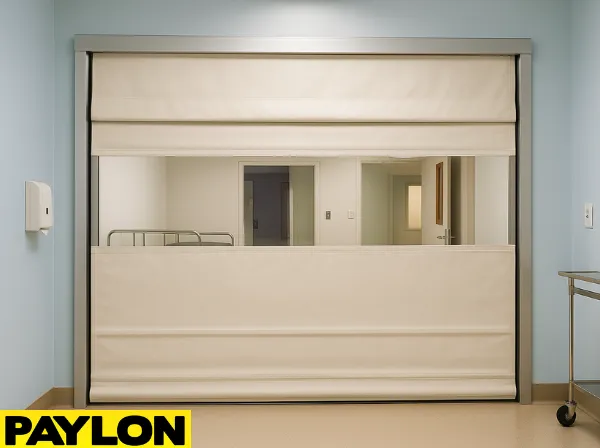
Here’s how they deliver value in healthcare spaces:
Support Infection Control Protocols:
These barriers form a physical seal that helps limit cross-contamination between high- and low-risk zones.
Minimize Air Disruption:
Quick open-and-close cycles reduce airflow disturbances, helping to stabilize temperature and air pressure in controlled environments.
Enable Smarter Space Management:
Whether you're segmenting a pop-up triage station or managing transitions between patient zones, these doors help staff move efficiently while keeping areas contained.
Ready for High-Frequency Use:
Designed for durability and fast cycling, motorized options withstand constant operation without performance drop-off.
Vinyl roll-up doors don't just meet facility standards, they help raise them. With the right setup, they become a seamless part of your infection control strategy, supporting both safety and operational efficiency.
Common Use Cases in Medical Settings
While vinyl roll-up barriers offer broad benefits, their real strength is how they adapt to the fast-paced demands of healthcare environments. From patient care to support operations, these doors solve everyday challenges in practical, flexible ways.
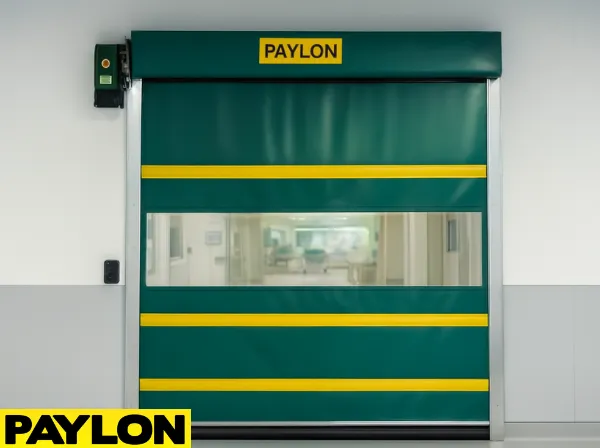
Here are just a few examples of how they’re put to work:
Emergency Screening Areas:
Vinyl barriers help rapidly section off open areas during high patient volume, supporting safe intake and controlled movement.
Testing Booths with Controlled Access:
These barriers create isolated spaces that allow observation and communication without direct contact, ideal for diagnostic and infectious disease testing.
Temporary Wards in Field or Overflow Hospitals:
In mobile or surge-care environments, they provide quick, clean separation to expand patient capacity on demand.
Sterile Supply and Staff Entry Zones:
Used to divide back-of-house areas or secure clean storage rooms, these doors help limit exposure between sterile zones and common corridors.
Every healthcare space operates differently, but with vinyl roll-up barriers, controlled separation is always within reach.
How Vinyl Roll-Up Doors Compare to Other Options
By now, you’ve seen how motorized vinyl doors support smooth, safe, and efficient park operations. But how do they stack up against other common door types? This side-by-side comparison gives you a clear view.
| Feature | Manual | Motorized | High-Speed |
|---|---|---|---|
| Operation | Spring-loaded or chain-hoist | Plug-in motor (in-tube or jackshaft) | Fast open/close motorized system |
| Best For | Occasional use in light-traffic zones | Consistent access in moderate to busy zones | Critical areas with constant activity |
| Max Size | Up to 12–16 ft wide | Up to 20 ft wide | Up to 25 ft wide |
| Sanitation Compatibility | Easy to wipe and sanitize | Compatible with hospital disinfectants | Built for frequent sanitation cycles |
| Optional Add-ons | Clear window panel | Motion sensors, safety edge, window inserts | Touchless activation, breakaway safety bar |
While each door type has its purpose, motorized vinyl roll-up doors offer a reliable, balanced solution, especially in spaces where traffic flow, sanitation, and operational uptime matter most.
Frequently Asked Questions
FAQs: Vinyl Roll-Up Barriers for Quarantine Zones
1. Can vinyl roll-up barriers be used in hospitals?
Yes, vinyl roll-up barriers are ideal for hospitals. They help create quick and hygienic separations between sterile and non-sterile areas, making them suitable for triage zones, corridors, and temporary isolation areas.
2. Are motorized vinyl roll-up doors compliant with healthcare sanitation protocols?
Absolutely. Motorized vinyl roll-up doors are made with FDA-compliant materials that withstand hospital-grade disinfectants and support frequent cleaning cycles without degrading.
3. What’s the best vinyl roll-up barrier for temporary triage zones?
High-speed vinyl roll-up barriers are often the best choice for temporary triage areas. They open and close quickly, reduce air disruption, and are built for high-frequency use.
4. Can these barriers provide visibility and privacy at the same time?
Yes. Many vinyl roll-up doors include optional clear PVC window panels that allow visibility while maintaining a physical barrier for infection control. Opaque vinyl options are also available when privacy is needed.
5. How are vinyl roll-up barriers installed in medical facilities?
Vinyl roll-up barriers are custom-fit to each opening and mounted using ceiling or wall brackets. Most installations require minimal modification to the existing structure and can be completed quickly.
6. Do motorized vinyl roll-up barriers support hands-free operation?
Yes, motorized vinyl roll-up barriers can be equipped with motion sensors or touchless activation systems, making them ideal for clean zones, quarantine areas, and hands-free workflow environments.
7. What are the sizing options for vinyl roll-up barriers in hospitals?
Depending on the model, vinyl roll-up barriers can span widths from 8 to 25 feet and heights up to 20 feet. They can be custom-sized to fit hallways, storage rooms, and mobile medical units.
8. Are vinyl roll-up doors suitable for mobile field hospitals?
Yes. Their compact design and easy setup make vinyl roll-up barriers perfect for mobile or pop-up medical centers. They create secure partitions in tents, trailers, and temporary treatment zones.
9. Can I buy vinyl roll-up barriers with fast delivery?
Yes, many vinyl roll-up doors are available with fast lead times and optional expedited shipping. Contact the manufacturer directly for custom sizing and availability.
10. What are the optional features available for motorized vinyl roll-up doors?
Common add-ons include clear window panels, safety edges, breakaway bottom bars, and motion sensors. These features enhance visibility, safety, and user convenience.
11. Do vinyl roll-up barriers support infection control protocols in cleanrooms?
Yes. Vinyl roll-up barriers help maintain air pressure control and are made from smooth, easy-to-sanitize surfaces, making them ideal for cleanroom and sterile environments.
12. Are vinyl roll-up doors reusable during emergency or surge events?
Definitely. Vinyl roll-up doors are durable and easy to reposition or reinstall, making them a practical solution during medical surges or temporary expansions.
13. How durable are motorized vinyl roll-up barriers in busy healthcare zones?
They are built to handle high-frequency use. Models with jackshaft motors are specifically designed for heavy-duty performance in fast-paced zones like ERs and ICU corridors.
14. Can I customize the color or transparency of vinyl roll-up doors?
Yes. You can choose from various vinyl colors and transparency levels, including fully clear, frosted, or solid panels depending on the desired level of visibility and privacy.
15. What’s the difference between manual and motorized vinyl roll-up barriers?
Manual barriers operate using a spring or chain-hoist system, ideal for low-traffic areas. Motorized models offer fast, hands-free access for high-use zones and can include smart automation features.
16. Are these barriers a cost-effective alternative to hard partitions?
Yes. Vinyl roll-up barriers offer a flexible and budget-conscious alternative to permanent walls, allowing healthcare facilities to adapt spaces quickly without major construction.
17. Can I use vinyl roll-up barriers for sterile supply storage rooms?
Absolutely. Vinyl roll-up doors help seal off clean supply areas from general traffic, reducing cross-contamination and maintaining compliance with hygiene standards.
18. Are these doors noisy during operation?
Not at all. Motorized vinyl roll-up barriers are engineered for quiet performance, which is crucial in hospitals, testing centers, and patient recovery areas.
19. Where can I install a motorized vinyl roll-up barrier in a quarantine facility?
Popular locations include patient intake corridors, pharmacy separation zones, supply closets, and back-of-house staff transitions. Their flexible sizing allows use almost anywhere.
20. How do I choose the right vinyl roll-up barrier for my medical facility?
Start by assessing traffic levels, hygiene needs, and available space. Then choose between manual, motorized, or high-speed models. For help customizing your setup, reach out for expert guidance and quotes.
Conclusion: Make Quarantine Zones Safer, Smarter, and Faster
Vinyl roll-up barriers offer a smarter way to separate spaces without slowing things down. With hygiene, speed, and adaptability built in, they’re a natural fit for today’s healthcare environments.

